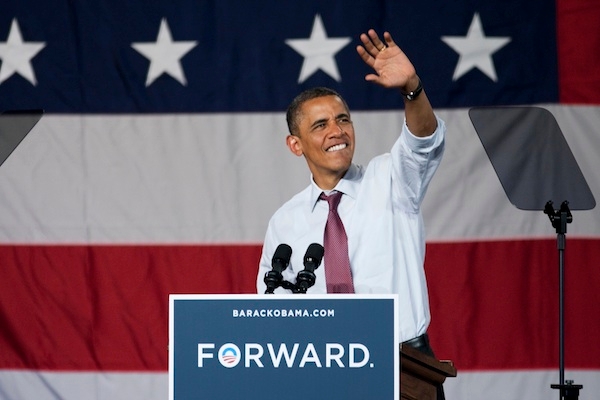It’s coming up fast: there are now just three months to go to Election Day in the United States. And right now, Barack Obama’s looking a good bet — although certainly not a safe one — for re-election. The forecasting model designed by the New York Times’s Nate Silver — which accounts for both polls and economic data — currently puts Obama’s chances of victory at 72.4 per cent, his strongest position so far.
Interestingly, though, Obama’s lead in the polls is not all that big. Silver’s model, which includes national and state-level polls and takes into account the house effects of each pollster as well as the difference between polls of ‘registered voters’ and those of ‘likely voters’, puts Obama’s lead at about 1.5 percentage points nationally. And that lead has actually narrowed recently, from almost 3 points two weeks ago. So how have his chances of victory improved?
There are two main reasons. One is the recent good economic news, including better-than-expected jobs figures last week and the upwards trend in the stock market since the beginning of June. This basically means there’s less chance of Romney turning the numbers around by November. The other reason is that the latest polls have shown Obama doing particularly well in key swing states. A Quinnipiac poll released last week, for example, had him beating Mitt Romney by 6 points in both Ohio and Florida, and by 11 in Pennsylvania. Those numbers are particularly noteworthy as Quinnipiac tends to show more favourable numbers for Romney than most pollsters, and because it polled likely voters, which tends to yield better results for the Republican candidate than polling registered voters.
Most troubling for Romney is that the polls have consistently shown him trailing Obama in Ohio — a state without which it’s very hard to see him securing the 270 electoral votes he needs. Silver’s ‘adjusted polling average’ now puts Romney 3.4 points behind in the Buckeye State, and his model gives Obama a 72 per cent chance of carrying it in November. Add to that Obama’s strength in the other Rust Belt swing states of Michigan, Wisconsin and Pennsylvania — where his chances are 88, 87 and 87 per cent respectively — and you can see why the President’s hold on the Electoral College is stronger than his hold on the national popular vote. Without any of these four states (and assuming Obama holds all the safe Democrat states), Romney would have to win all the states McCain did in 2008 plus all of Indiana, North Carolina, Florida, Virginia, Colorada, Iowa and Nevada. While he leads strongly in Indiana and less strongly in North Carolina, and both Florida and Virginia look very close, winning all seven of those states is a very tough task for the Republican nominee.
Of course, there’s still a way to go and we’ve got three big set pieces coming up. There’s Romney’s announcement of his Vice Presidential nominee — probably Ohio Senator Rob Portman or former Minnesota Governor Tim Pawlenty — which you can expect between the Olympics closing ceremony on Sunday and the start of the Republican convention a fortnight later. Then there are the two parties’ conventions themselves, with first Romney and then Obama giving their big nomination acceptance speeches. While each of these three events tend to produce a temporary bump in the polls (the first two for the challenger, the third for the incumbent), there’s little evidence that any of them have a significant effect on the result of the election, beyond maybe two or three points for the challenger in his VP nominee’s home state. Romney’s going to need a much bigger shift than that if he’s to defeat Obama in three months time.






Comments